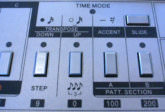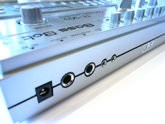
Jazz legend Oscar Peterson showing off Roland’s intended use for the TB-303 and TR-606
TT-303
At roughly half the price of an original vintage unit, the TT-303 is clearly an attractive proposition. The synth section of the TT-303 is, essentially, a near-exact copy of the TB-303, reverse-engineered then rebuilt using the closest contemporary surface-mount equivalents of the components used in the original. Run through the TT’s self-tuning routine (a very modern and much welcomed feature not present on the original) and the synth immediately plays perfectly in tune with sawtooth and square waves which sound very close to the distinctive unfiltered oscillator tones of the original:
Robin Whittle, inventor of the Devil Fish mod, is one of the world’s foremost experts on the intricacies of the TB-303’s circuits and, as such, far better placed than us to comment on the accuracy of Cyclone’s recreation of the 303 circuit. Robin has written extensively about the technical aspects of the TT-303 on his website. For anyone with an interest in the technical side of the TT, it’s certainly worth a read. The brief synopsis is that the TT-303 is close enough to the circuit of the real thing that virtually all of the Devil Fish mods can be carried out. That doesn’t necessarily mean that it’ll sound like the original unless the components are carefully chosen, but it’s definitely a very close soundalike in this case:
Sequencer

The updated sequencer section
One feature of the TB which many would argue shouldn’t be cloned is the sequencer. The TT-303 takes a slightly different approach. The main focus of the sequencer’s operation is Pitch mode, in which notes are entered step by step. Pick a note, select an octave, add accent, slide or tie if desired, then press Next to move onto the next step. The Back button allows you to go back through what you’ve already entered and edit if necessary. It’s a nice update of the 303’s notoriously fiddly setup (although, as A Guy Called Gerald pointed out when we interviewed him last year, there is a very easy way to get to grips with the 303’s sequencer: RTFM).
The omission of the TB’s Tap mode is a bit of a shame, but in their place you’ll find a number of new features which build on the options found on the original. The InstaDJ mode and the Bot pattern generation functions sound like the kind of hideous gimmicks you’d expect on an entry-level synth, generating loops at the touch of a button based on seven different ‘personality algorithms’, but they’re actually quite useable.
The Mutate function in particular is an excellent idea, warping and twisting patterns into slightly different shapes when triggered. It’s unpredictable – that’s the nature of the beast – but it can be used very effectively to keep a pattern interesting over the course of a track by subtly switching up the rhythm or order of notes. A great option for live performance. (The Mutate function is also a hell of a lot more user-friendly than the equivalent hack on the original: letting the batteries run so low that the patterns in memory became corrupted.)

CV and gate outputs retained
The inclusion of a MIDI input alongside the CV and gate connections also makes it easier to control the synth via your DAW. It’s worth noting, too, that a splitter cable allows the single 8-pin DIN socket to function as both MIDI input and output. Without the adapter, the socket functions as a MIDI input via a standard 5-pin MIDI cable. The output can be used to control other gear but also serves double duty as a way of backing up patterns via MIDI SysEx. On that front, the BassBot can store up to 224 patterns, each of which can be colour-coded using the multi-colour LEDs; a big improvement on the TB’s 64 patterns, not least because the TT’s non-volatile memory means that patterns are retained even without batteries installed.
As a consequence of the added MIDI capabilities, the TT ditches the TB’s DIN sync option, which is mainly a concern to anyone intending to hook it up with other vintage gear. For anyone wanting to sync the TT-303 with a 606 without the hassling of a MIDI to DIN sync converter, we’re informed that Cyclone have a solution up their sleeve in the shape of a forthcoming TT-606 Drum Drone drum machine, also equipped with MIDI. No prizes for guessing what that one’s based on…
Conclusion
Comparing the TT-303 with the real TB-303 is inherently flawed due to the simple fact that the newest TB-303s are now approaching 30 years old. At the very least, for a totally fair test you’d have to replace all those ageing capacitors in the TB-303 with brand new equivalents of identical spec, which is clearly impossible. The same applies to the physical components too; apparently the knobs on original TBs were equally as stiff as those on the TT until they’d been turned a few hundred times. Then there’s the price difference to take into account.
But that comparison-based approach misses the point in our opinion. If you’re looking at the TT-303 then you’re probably a musician rather than a collector. The top priority must surely be whether it sounds good. And on that front the TT-303 definitely doesn’t disappoint. This is an intuitive, engrossing instrument which can certainly slot into any retro or modern track as effectively as the original. The changes to the sequencer and the addition of MIDI only serve to make it more user-friendly for most modern studio setups. A future classic like the real thing? Maybe not, but at this price let’s just enjoy it for what it is: a very enjoyable, great-sounding synth which just happens to do a highly convincing impression of a TB-303.
The Verdict
Price: £529.99
Purchase: Cyclone Analogic TT-303 BassBot
The Final Word
A modern take on the 303 with the classic TB sound. Sensible updates make it easier to fit into a modern studio.

07.15 AM
Nice review.
11.31 AM
good read
11.41 AM
ace review, I think I’ll stick with my x0xb0x though. I think it’s a bad move to put a clone in a near-identical case. I’m writing my dissertation on the fetishisation of music technology and this article definitely comes in handy!
07.55 PM
Dear djoremi.
the TT Bass box is miles better than the x0xb0x
period. I have both
08.04 PM
Ive just sold my xoxbox and got the bassbott tt, the xox box isnt a patch on the bass bot, even though it sounds nice with a destortion pedal, the bass bot is a replica of the tb303, i have both an original and a bass bot, the only difference is theres no little plasticy leather bag lol
02.43 AM
Best clone out there!
And it looks close to the original as it should.
Let’s hope they will do a TR-606, TR-808, TR-909 as well.
08.51 PM
But… you are test the TT-303 whith a distortion??
What appens?? what is whrong? sounds very bad!!!
You are connect the TT-303 in a osciloscope? hahahaha
It’s a joke of machine! bad emulation! hahahahah
08.57 PM
It’s a good toy for play, but not a good machine for profesional studio.
The wave generates a peak of noise and artifacts! that destroy the sound.
Not a profesional like a TB-303 or x0xb0x
03.47 PM
Oh, Jem. You really sound like you know what you are talking about……… XD
01.55 PM
Jem you are having a laugh! I’ve owned 2 TB 303s over the years and have had several x0xb0x from various builders and the TT 303 wins hands down every time for me if you want the perfect TB clone. The distortion debate is completely groundless and a blatant attempt at sabotaging the TT 303s reputation, have had no issues with any distortion pedals or through software for that matter! x0xb0x’s are good don’t get me wrong but they are built by hand so it really all depends on how good your builder is and try finding one that comes with a 3 year warranty.
10.25 PM
It’s not the maxhine! it’s the humanimput! If you are a good misician, you will compose a great piece of music on anything comes handy!
03.36 PM
TT-303 -5% off
Use coupon code: TTdiscount5
on the webshop: http://www.cyclone-analogic.fr
11.04 PM
Ive had this instrument for a while now. My advice is if your looking for a 303 but you aint got a spare £3k then grab one of these bad boys. Ive taken it out LIVE using Strymon reverb an delay pedals on a mackie mixer……..absolutely no distortion. Dont listen to pricks like Jem who must have broke his toys falling out him mums pram. Jem did you spend £3k on an original or was is it passed down by some ex music legend who hated 303s when they first came out.
TT303 makes SICK ACID MUSIC. simple
12.44 PM
Errr…Jem the original TB-303 was a budget toy for the busking/pub musician who wanted to have a bassline play along with his guitar! Defo was not a professional Studio tool, until Acid came along. I have a TT-303 and love it, basically for the price you cannot go wrong.
01.32 PM
Jen wtf is a ‘peak of noise’
You can’t compare a x0xb0x bc they are not all made equally , sometimes not even with the correct parts, of bad quality or damaged right parts.
I don’t think I have ever heard any clone of the 303 or any Roland classic that gets that glassy Rez point right. But the tt303 is the closest all round. It isn’t perfect, but it is closest.
What is clear is this simple bass machine can drive adults into childish name calling, which is at total odds with the ‘one love’ acid house movement of the late 80s , ironic.
09.05 PM
For Jem, and all the doubters, here’s a quote from Robin Whittle the mad scientist behind the Devilfish 303. Here is what he has to say about the VCA circuitry. To sum it up if you have reading comprehension difficulty the Bass Bot is quieter.
” The VCA is a BA6110, which is a modern, enhanced, version of
the original and now unobtainable BA662. The BA6110 has
linearizing diodes, which are not used, so it behaves much
like a BA662. The control current to the VCA is approximately
doubled and the load resistor for the VCA is approximately
halved. The signal level is about the same, but these changes
reduce the VCA’s background noise significantly. “
06.03 PM
Excellent review & thanks to all for commenting. I own one and love it! Great machine.
Really digging the roll out feature, saving arpeggiator results to new patterns, mutate… Even editing the thing is quick and easy. Its well worth the money!
10.58 PM
I bought a TT and have used a TN a lot in the past as well (plus all the other hardware and software variations and types over the years from Rebirth to Phoscyn and BassStations to MAMA 303 etc etc).
So I think I have tried a fair amount of real and clone 303s to have an opinion. I must say I really like the TT and think it does a great job and is easy to use.
The ‘techno vintage purists’ will hate it, but hopefully, music makers will love it and make great music with them.
So I’m all for it and am very happy with the one I own.